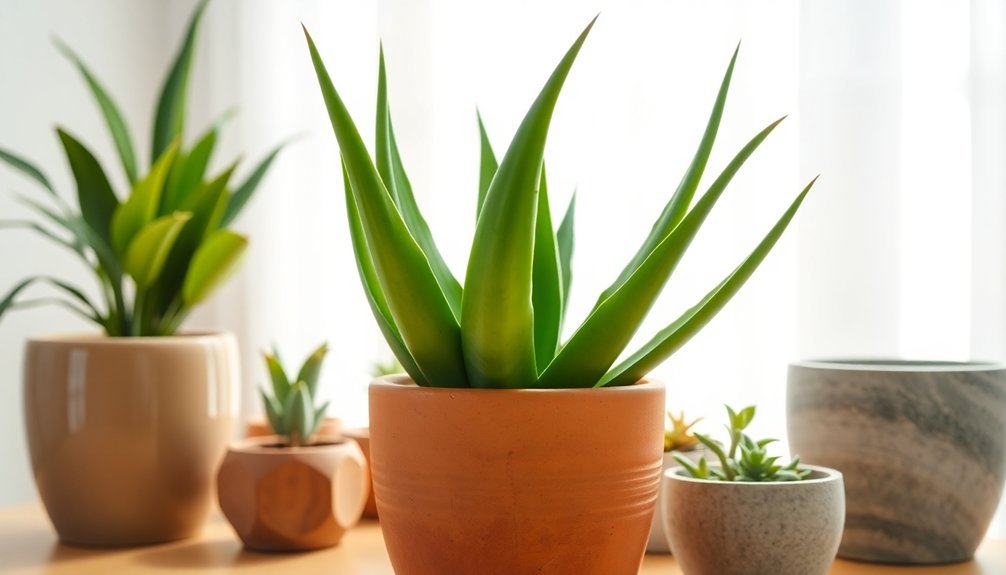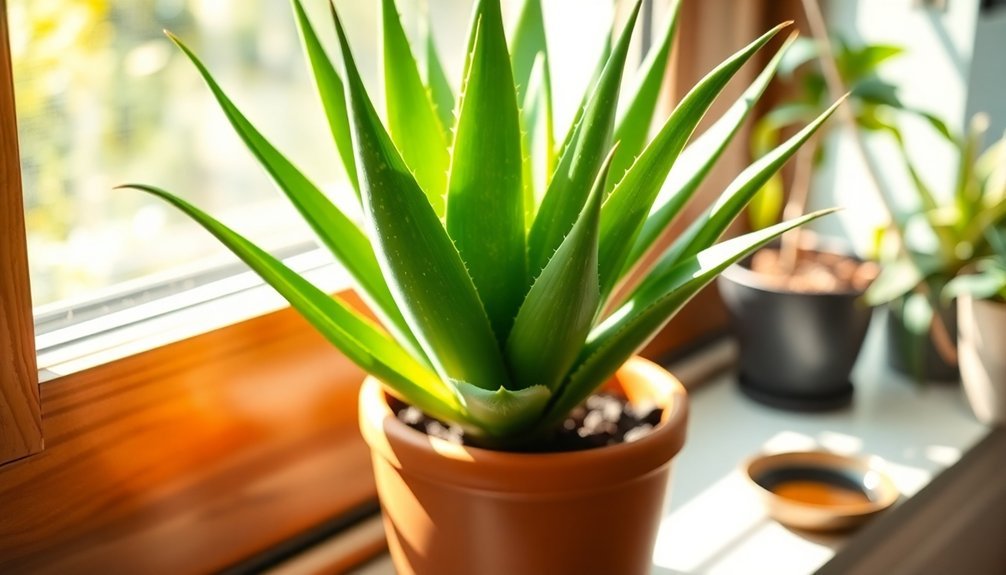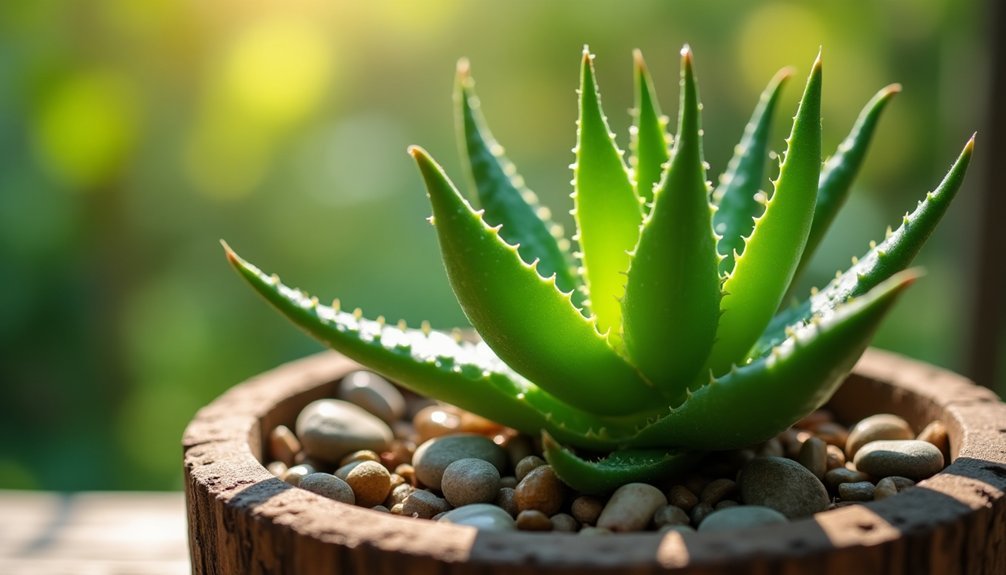Your aloe will thrive with bright, indirect sunlight for 6-8 hours daily near south or west-facing windows. Water only when the soil feels dry about two inches down, using well-draining soil in a terra cotta pot with drainage holes. Keep temperatures between 55°F-80°F and maintain moderate humidity levels of 30-50%. Feed with a balanced fertilizer during growing season, and watch for signs like leaf color and firmness to gauge plant health. There's much more to discover about maximizing your aloe's growth potential.
Understanding Your Aloe's Light Requirements

Three key light conditions are essential for your aloe's success: bright indirect sunlight, proper duration, and seasonal adjustments.
Your aloe needs 6-8 hours of bright, indirect sunlight daily, which you can provide by placing it near a south or west-facing window. Since aloes are naturally drought tolerant, they can withstand periods of intense light better than many other houseplants.
While your aloe can handle some direct sun, too much exposure will scorch its leaves.
Watch for signs of light-related issues: pale or yellowing leaves indicate insufficient light, while brown, shriveled leaves suggest too much direct sun.
If your plant starts leaning toward the light source, rotate it regularly for balanced growth.
When natural light isn't enough, supplement with LED grow lights or fluorescent tubes positioned 6-12 inches above the plant.
During winter, move your aloe closer to windows to maximize light exposure.
Creating the Perfect Watering Schedule
You'll know it's time to water your aloe when the soil feels dry about two inches below the surface, so stick your finger into the soil to check before reaching for the watering can.
Once you've confirmed the soil is dry, give your plant a thorough soaking until water flows freely from the drainage holes at the bottom of the pot.
This deep watering technique guarantees the roots receive adequate moisture while preventing the problems that come from frequent, shallow watering sessions. During the growing season periods, your aloe will need weekly watering to support its active growth and development.
Watch For Dry Soil
Creating a proper watering schedule for your aloe vera starts with understanding when the soil needs moisture.
You'll need to check the top inch or two of soil before watering – it should feel completely dry to the touch. Watch your plant's leaves closely, as they'll show signs of wrinkles or drooping when water is needed. Using a well-draining succulent mix will help prevent waterlogged roots and ensure healthy growth.
- During the growing season, water your aloe weekly, but adjust for temperature and humidity levels – hot weather may require more frequent watering.
- In winter, reduce watering to every two weeks as the plant enters its dormant phase.
- Young plants need slightly more frequent watering than mature ones, but always let the soil nearly dry between waterings.
Pay attention to overwatering signs like yellow leaves or soft, squishy texture, which can indicate root rot.
When To Water Deep
When establishing a deep watering routine for your aloe vera, proper timing and technique are essential for healthy root development.
You'll want to water thoroughly until you see drainage from the bottom holes, ensuring the water reaches deep into the root system.
During spring and summer, water deeply once a week, while in winter, reduce this to every two weeks.
If you're growing aloe indoors, you might need to adjust this schedule based on your home's heating and humidity levels.
For outdoor plants in full sun, you'll need more frequent deep waterings during hot weather.
Always use room temperature water and direct it at the soil's base, avoiding the leaves.
Remember that mature plants can withstand longer periods between deep waterings, while younger ones need slightly more frequent attention.
Managing Temperature and Humidity

Your aloe needs temperatures between 55°F and 80°F to thrive, so keep it away from cold drafts and freezing conditions that can damage its sensitive tissues.
While you don't need to worry about maintaining high humidity levels, your plant will do just fine in normal indoor conditions around 40% humidity.
You'll want to monitor the temperature especially during winter months, bringing your aloe indoors before temperatures drop below 50°F to protect it from cold damage.
Optimal Temperature Range
While aloe vera plants are particularly resilient, they thrive best in temperatures between 65-75°F (18-24°C).
You'll find these desert plants can handle indoor temperatures as low as 50°F (10°C), though they may show signs of stress. For ideal growth, maintain temperatures between 55-80°F (13-27°C), and never let them drop below 40°F (4°C).
Your aloe can adapt to various conditions, but you'll want to follow these temperature guidelines:
- Keep your plant away from heating vents and air conditioners to avoid temperature fluctuations.
- Move outdoor plants inside when temperatures approach 40°F (4°C).
- Provide partial shade during hot seasons, as direct sunlight can cause dehydration, even though they can tolerate temperatures up to 100°F (38°C).
Avoiding Cold Drafts
Although aloe vera plants are hardy desert natives, they're sensitive to cold drafts that can shock their system and stunt growth. To protect your plant, keep it away from windows and doors where cold air can seep in. If you must place your aloe near a window, use curtains or blinds as a barrier against chilly drafts.
You'll want to position your aloe away from heating vents and air conditioning units, as these create temperature fluctuations that stress the plant.
During winter months, maintain indoor temperatures between 18-20°C (64-68°F). If you're growing aloe outdoors, bring it inside before temperatures drop or protect it with frost cloth.
For added insulation, apply mulch around the base of outdoor plants to regulate soil temperature and retain moisture.
Humidity Level Needs
Beyond protecting aloe from cold drafts, maintaining proper humidity levels plays a key role in the plant's health. Your aloe vera will thrive in humidity levels between 30% and 50%, which you'll typically find in most indoor environments.
If you notice brown leaf tips or wilting, your plant's likely struggling with low humidity, while soft, mushy leaves indicate excess moisture.
To maintain ideal humidity for your aloe:
- Use a hygrometer to monitor levels regularly, especially during seasonal changes
- Combat dry air with a humidifier or pebble tray during winter months
- Improve air circulation with fans and use terracotta pots to prevent moisture buildup
Remember to adjust your care routine based on the seasons, as indoor heating can dry out the air in winter, while summer might bring unwanted moisture that requires dehumidification.
Selecting the Right Soil Mix
Since aloe vera's survival depends on proper drainage, selecting the right soil mix is essential for its health.
You'll need a well-draining mixture that's about two-thirds coarse materials. Combine equal parts potting soil, coarse sand, and perlite as your foundation, then adjust based on your plant's needs.
Keep your soil's pH between 6.0 and 7.0, with 6.5 to 6.8 being ideal. You can monitor this using a pH meter and make adjustments with garden lime if needed.
For the best results, try a homemade mix of 2 parts potting soil, 1 part perlite, and 1 part coarse sand. You can also add compost for extra nutrients, but don't use traditional all-purpose potting soil alone as it retains too much moisture and risks root rot.
Choosing the Optimal Pot and Container

Selecting the right pot for your aloe vera involves three key factors: material, size, and drainage. For ideal growth, choose porous materials like unglazed clay or terra cotta, which provide excellent airflow and help regulate soil temperature.
While ceramic and plastic pots can work, they must have adequate drainage holes to prevent root rot.
- Pick a pot that's proportional to your plant's size, typically increasing by one or two sizes when repotting (e.g., from 4" to 6").
- Look for signs that you need a larger pot, such as wilting leaves or overcrowded roots.
- Guarantee proper drainage through holes at the bottom and use a well-draining soil mix.
Remember that aloe's root system spreads more than it deepens, so choose a container that allows for horizontal growth while maintaining stability.
Mastering Fertilization Techniques
Proper fertilization plays an essential role in maintaining healthy aloe plants. You'll want to feed your aloe only during its growing season from March to September, applying fertilizer every 15-20 days if using organic options.
Choose water-soluble fertilizers with a 2-4-8 NPK ratio, or opt for slow-release granules at half strength. You can also use organic alternatives like worm castings or compost.
Before applying any fertilizer, water the soil lightly and verify it's well-draining. For best results, dilute liquid fertilizers to quarter strength and apply them in the evening.
Mix your potting soil with gritty materials like sand and perlite to improve drainage.
Remember to avoid high-nitrogen fertilizers and stop feeding during the winter months when your aloe's growth naturally slows down.
Identifying Signs of Plant Health

Beyond feeding your aloe plant correctly, keeping an eye on its appearance helps you spot and address problems early. Healthy aloe leaves should be plump, firm, and vibrant green, growing upward rather than horizontally. You'll know something's wrong when these characteristics change.
Watch for these key indicators of your aloe's health:
- Water issues: Brown tips suggest underwatering, while black spots and mushy texture indicate overwatering. If leaves wrinkle or curl, your plant needs a drink.
- Light concerns: Flat leaves mean it's not getting enough light, while browning suggests too much direct sun. Proper light exposure keeps growth pointing upward.
- Temperature sensitivity: Don't let your aloe experience temperatures below 55°F, as this can damage leaves and slow growth. Maintain consistent temperatures for ideal health.
Dealing With Common Aloe Problems
While aloe plants are generally hardy, they can face several common problems that require prompt attention.
If you notice dark spots with puncture marks, you're likely dealing with snout beetles – treat the affected areas with systemic insecticide.
For aphids and mealybugs, which often cluster in the plant's center, use high-pressure water or neem oil.
Keep an eye out for spider mites, which may require specific chemicals like Kontos or Sevin concentrate.
Fungal issues are also common.
Watch for black circular spots indicating aloe rust or leaf spot disease, and remove infected leaves carefully.
Root rot, typically caused by overwatering, requires immediate action – improve soil drainage and reduce watering frequency.
Remember that fungus gnats can be prevented by letting soil dry between waterings.
Propagating Your Aloe Plant

Propagating aloe plants offers several reliable methods to expand your collection. You can choose from techniques like offset division, leaf cuttings, plant division, or seed propagation, with offset propagation being the most successful method.
- If you're using offsets (pups), locate the small shoots at the plant's base, separate them with clean shears, and let them callus before replanting.
- For leaf cuttings, select a healthy outer leaf, cut it near the stem, allow it to dry, and plant the callused end in well-draining soil.
- When dividing the plant, carefully separate the rosettes with their roots intact, let them dry briefly, and plant each division in its own pot.
Remember to provide indirect sunlight and moderate water for all propagation methods.
While seeds are an option, they require more patience as germination can take several weeks.
Seasonal Care Adjustments
Your aloe plant will need more frequent watering during its active summer growth period, while winter calls for considerably reduced watering as the plant enters its natural rest phase.
Spring marks the ideal time to begin your yearly fertilizing schedule, using a balanced fertilizer just once to support the upcoming growth season.
You'll want to maintain consistent monitoring of soil moisture throughout the seasons, adjusting your care routine based on your plant's specific environment and growth patterns.
Summer Growth and Water
During summer's peak growing season, aloe vera plants require consistent attention to their watering needs and environmental conditions.
You'll need to water your plant weekly, but always check that the top 2 centimeters of soil are dry first to prevent overwatering. If you notice your aloe's leaves turning red, move it to a spot with less direct sunlight while still ensuring it gets at least six hours of bright, indirect light daily.
- Monitor soil moisture carefully, as high temperatures can increase your plant's water requirements.
- Keep temperatures between 55°F and 80°F for ideal growth.
- Watch for pink blooms in late spring and summer, but remember that flowering plants need more frequent watering.
Remember to wipe the leaves periodically with a damp cloth to maintain efficient photosynthesis during this active growth period.
Winter Rest Period
While temperatures drop and days shorten, aloe vera plants enter a natural dormancy period that requires specific winter care adjustments.
Keep your plant in temperatures between 10-20°C, away from cold drafts and heat sources. Place it on a bright windowsill where it'll receive 6-8 hours of indirect sunlight daily, or supplement with grow lights if needed.
During winter, you'll need to reduce watering considerably to about once a month or less. Wait until the soil dries completely before watering again.
Don't fertilize or prune your aloe during this rest period, as the plant needs to conserve energy. Avoid repotting unless absolutely necessary, and keep an eye out for any signs of stress or disease, though these are less common in winter months.
Spring Fertilizing Schedule
Spring awakens aloe plants from their winter slumber, signaling the perfect time to begin a regular fertilization schedule. Choose a liquid fertilizer designed for succulents and dilute it to half strength for best results.
You'll want to start fertilizing in March or April when your plant enters its active growth phase.
Your fertilization frequency depends on your plant's location and maturity level:
- Indoor aloes need feeding every 2-3 months during growing season
- Outdoor plants require fertilization every 4-6 weeks due to increased sun exposure
- Young plants benefit from monthly feedings, while mature ones need it every other month
Before applying fertilizer, water your plant thoroughly the day before to flush out salt buildup.
Apply the diluted solution directly to the soil around the plant's base, avoiding the leaves unless you're using a foliar spray outdoors.
Positioning Your Aloe for Success

Successfully growing an aloe plant depends heavily on proper positioning, as these succulents have specific requirements for light, temperature, and space.
Place your aloe in a brightly lit spot, preferably near south or west-facing windows, where it'll receive 2-3 hours of sun daily. You can move it outdoors to a sunny patio during summer, but bring it inside before autumn's cold weather arrives.
Keep it away from cold drafts and air conditioning vents to maintain consistent temperatures.
Use a wide, porous pot that's slightly larger than your plant, filled with well-draining cacti soil. Add a layer of gravel on top to reduce evaporation.
Verify your pot has a sturdy base, as aloe leaves become heavy with gel. For convenience, you might want to keep it in your kitchen, where you'll have easy access to its soothing properties.
Maintaining Healthy Growth Patterns
Once you've positioned your aloe properly, maintaining its healthy growth requires a thoughtful balance of water, soil, and care.
You'll need to establish a consistent watering schedule, allowing the soil to dry completely between waterings – every 2-3 weeks in growing season and 3-4 weeks during dormancy.
For ideal growth, follow these key practices:
- Use a well-draining succulent mix with a 2:2:1 ratio of potting soil, coarse sand, and pumice or perlite.
- Keep temperatures between 60-80°F, and protect your plant from cold below 55°F.
- Fertilize monthly during spring and summer with a phosphorus-rich formula, or just once annually in spring.
Check the top inch of soil before watering and always use containers with proper drainage to prevent root rot.
Frequently Asked Questions
Can I Use Aloe Vera Gel Directly From the Plant on My Skin?
Yes, you can safely apply aloe vera gel directly from the plant to your skin. Just remember to do a patch test first to check for any allergic reactions, and wash the area before application.
How Long Does an Aloe Vera Plant Typically Live?
Your aloe vera plant can live 10-12 years indoors and 15-20 years outdoors in warm climates. With proper care and ideal conditions, you'll see it thrive even longer, especially if it's planted in-ground.
Is Aloe Vera Toxic to Pets if Ingested?
Yes, aloe vera is toxic to pets if ingested. If your pet consumes it, they'll likely experience vomiting, diarrhea, and dehydration. The plant's aloin can cause serious complications, so keep it away from pets.
Why Is My Aloe Plant Turning Purple or Reddish?
Your aloe's purple or reddish color is likely due to stress from environmental factors. You'll want to check for issues like too much sun, improper watering, temperature extremes, or nutrient imbalances.
Can I Grow Aloe Vera From a Leaf Cutting?
Yes, you can grow aloe vera from leaf cuttings, but it's tricky. You'll need to cut a healthy outer leaf, let it callus for a few days, then plant it in well-draining soil with minimal watering.
In Summary
You'll find that caring for aloe isn't complicated once you understand its basic needs. Keep your plant in bright, indirect light, water only when the soil is completely dry, and maintain temperatures between 55-80°F. Use well-draining soil, choose a pot with drainage holes, and watch for signs of overwatering. With these simple practices, your aloe will thrive and provide you with healthy, useful leaves for years.
References
- https://www.patchplants.com/gb/en/read/plant-care/how-to-look-after-your-aloe-vera/
- https://bloomscape.com/plant-care-guide/aloe/
- https://www.plantsavvy.com/blog/how-to-care-aloe-vera-plant
- https://www.goodhousekeeping.com/home/gardening/g19682442/aloe-plant-care/
- https://hips.hearstapps.com/hmg-prod/images/varieties-of-aloe-vera-66a28870f263a.jpg?sa=X&ved=2ahUKEwjql-G1zqOLAxUztYQIHXTqOYoQ_B16BAgKEAI
- https://florasense.com/blogs/optimal-light-requirements-for-thriving-aloe-vera-plants/
- https://www.proflowers.com/blog/aloe-vera-care
- https://soltech.com/products/aloe-plant-care
- https://www.wildinteriors.com/blog/how-to-care-for-aloe
- https://libguides.nybg.org/aloe
- https://florasense.com/blogs/aloe-vera-watering-guide-how-often-and-how-much/
- https://www.tomsguide.com/how-to/how-to-care-for-an-aloe-plant-7-tips-you-need-to-know-now
- https://www.thespruce.com/how-often-to-water-aloe-vera-plant-8684823
- https://www.joyusgarden.com/aloe-vera-an-easy-care-succulent/
- https://www.epicgardening.com/aloe-water/
- https://www.bathgardencenter.com/post/how-to-care-for-an-aloe-vera
- https://planetdesert.com/blogs/news/aloe-vera-plant-care-health-benefits-types-of-aloe-vera
- https://fifthseasongardening.com/a-helpful-houseplant-aloe-vera
- https://www.youtube.com/watch?v=1Ya56UEZ9OI
- https://www.houseplantjournal.com/houseplant-qa/watering-an-aloe-plant/





Leave a Reply